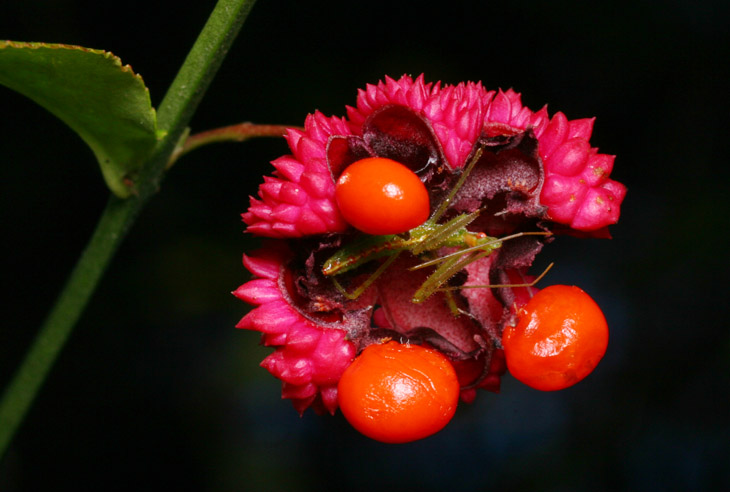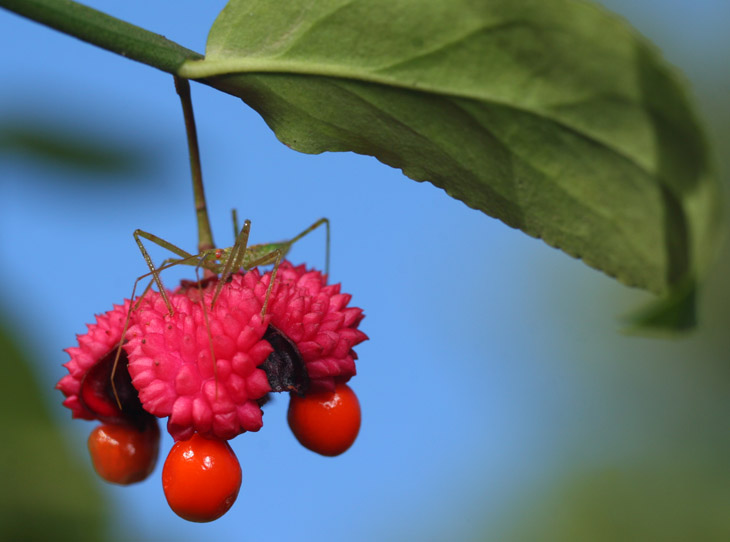So, the important stuff first: with this post I surpass all previous records for posting within a year, and we’re only in mid-October! Everything past this point is gravy, and even if I stop posting now, I’ve still got that accomplishment under my belt. It’s a warm fuzzy feeling, let me tell you.
A lot of this is due, naturally, to starting this whole “Monday color” thing in the first place, responsible for 39 posts all by itself, not to mention even more images, so it seems only appropriate that I am adding to them with this post, which does serve more of a purpose that gloating, or simply pushing the count over the line. Because it actually follows-up with some things talked about in the previous post.
On taking a casual peek at the Euonymus americanus (or hearts-a-bustin’) tree in the yard today, several days after the images from the previous post, I spotted a new occupant of one of the seed pods, and fetched the camera for a trivial sequel shot.

This pale green assassin nymph (Zelus luridus) had taken shelter within the overhang of the seed pod, adding another layer of color to the layout. I did some quick initial shots, producing the same ‘night macro’ effects as earlier, though if you look close there are faint hints of blue from sky visible through small gaps in the foliage. I then decided to go back out and revisit the subject with a little more effort. During that delay, the assassin had left the shelter (where presumably it had maintained a tad more warmth than being fully out in the open last night) and was now perched atop the husk. Moreover, the sun had shifted and was actually falling onto the pod now. Okay then.
 Able to get a decent angle against the sky with this one, I first did the standard exposure – with the macro rig, I have a fixed exposure at 1/200 second at f16, ISO 200, and the flash output is right in line for this. As before, the bright sky came through with some color, though notably deep. It’s okay, but definitely not a natural look. As I first loomed in close, the assassin went into defensive posture, drawing the legs up as protective bars – this is a common trait with the species, and it often serves to obscure the eyes, which is a no-no for nature photography, so finding the angle where a red compound eye remained visible was important.
Able to get a decent angle against the sky with this one, I first did the standard exposure – with the macro rig, I have a fixed exposure at 1/200 second at f16, ISO 200, and the flash output is right in line for this. As before, the bright sky came through with some color, though notably deep. It’s okay, but definitely not a natural look. As I first loomed in close, the assassin went into defensive posture, drawing the legs up as protective bars – this is a common trait with the species, and it often serves to obscure the eyes, which is a no-no for nature photography, so finding the angle where a red compound eye remained visible was important.
Next, I shut the flash off and switched to aperture-priority, bracketing a few frames to see what settings I could get away with in completely natural light; again, this was possible because light was actually falling onto the seed pod this time around, whereas for the previous post they had all been in shade.

Not bad, but the shadows are a tad dark under the seed pod, and the light angle not quite ideal for the assassin, though now the sky is acceptable. So, now the challenge is to get the right level of ‘fill-flash’ to balance out the exposure and get good light on the subject, without looking like a spotlight. The FP38 flat-panel flash I was using has a fixed output, so it was a matter of adjusting the angle and distance (mostly aiming above the subject) to reduce the light output to the desired level. With a fixed flash, this could also be done with layers of diffusing material, but I already had a softbox diffuser on it in the first place, a routine part of my macro rig. Eventually, I got the level I was after.

In comparison to the others, the sky still came out slightly dark, but by itself it can easily be mistaken for a natural-light shot. Not the most compelling of images, especially for showing off an assassin bug (the stem should definitely not be right behind the bug,) but it illustrates the lighting thing well – better angles were prevented by other branches. In fact, the leaf peeking in at lower left was too prominent in a couple other frames where the lighting was even better – another hazard of macro work, since while looking through the viewfinder before the aperture has closed down, leaves and branches that are actually in the way may not be seen, only appearing in the final image because the depth-of-field has increased. This post illustrates how this can occur.
While I’m posting, I figure I’ll mention that the Orionids meteor shower peaks on the nights of the 21st and 22nd, if you have the interest. I went out for the previous shower and watched the sky for a bit, resolving to set up the camera for long exposures if the activity appeared decent. Alas, I didn’t see one, and with the light pollution nearby, very long exposures are pointless – the sky will wash out and might obscure any meteors that were actually captured. Perhaps we’ll see if this one fares any better – if I’m successful, you know you’ll see it here, even though I can be lazy about posting now.




















































